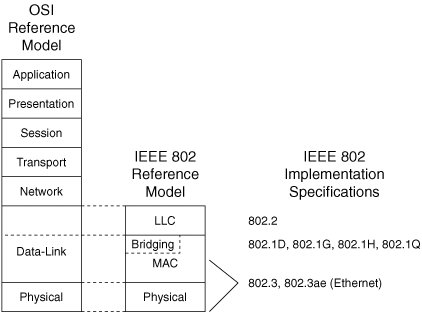Ethernet and the IEEE 802 Reference Model
| The IEEE 802 reference model defines three layers: logical link control (LLC), medium access control (MAC), and physical (PHY). Bridging functions are considered a sublayer within the MAC layer. The LLC and MAC layers map to the OSI data-link layer. The PHY layer maps to the OSI physical layer. The IEEE 802.3 specification derives from Ethernet II. Today, nearly all Ethernet LANs are 802.3 compliant. A separate amendment, known as 802.3ae, specifies 10-Gbps operation. The frame format of Ethernet II has been merged into 802.3 by allowing the third field of the 802.3 header to be interpreted as either length or type, depending on the numeric value of the field. The 802.3ae specification uses the same frame format. When the third field is interpreted as length, the 802.3 header is followed by the 802.2 header in the PDU. (One notable exception to this rule is the 802.3 raw frame format used by Novell NetWare in the past.) Combined, 802.3 and 802.2 provide full OSI physical layer functionality plus all OSI data-link layer functionality except for bridging-related services. The 802.1D, 802.1G, 802.1H, and 802.1Q specifications provide OSI data-link layer bridging functionality. Alternately, when the third field of the 802.3 header is interpreted as type, the 802.2 header is omitted from the PDU. The 802.3 service then provides full OSI physical layer functionality plus limited OSI data-link layer functionality. The type field enables identification of the intended upper layer protocol at the destination host (also known as the destination EtherType). This is important because it enables demultiplexing of OSI network layer protocols, which is a subset of the functionality provided by the 802.2 header. Figure 2-4 compares the IEEE 802 reference model to the OSI reference model and lists the relevant Ethernet specifications. Figure 2-4. IEEE 802 Relative to OSI Note IEEE specification names are case sensitive. For example, 802.1q is not the same as 802.1Q. Lower-case letters indicate an amendment to an existing standard, whereas upper-case letters indicate a full standard that might or might not incorporate various amendments. |
EAN: 2147483647
Pages: 196
